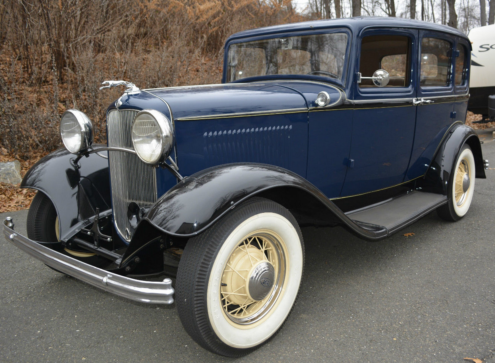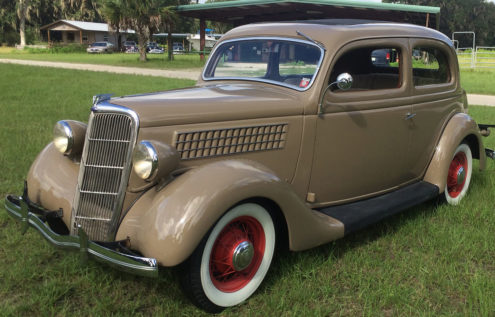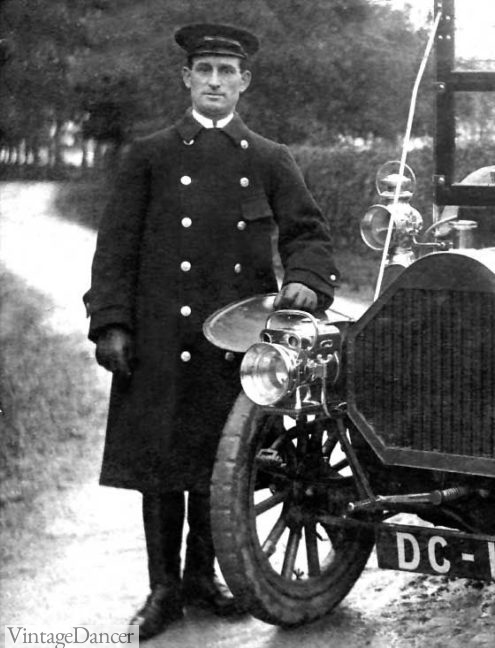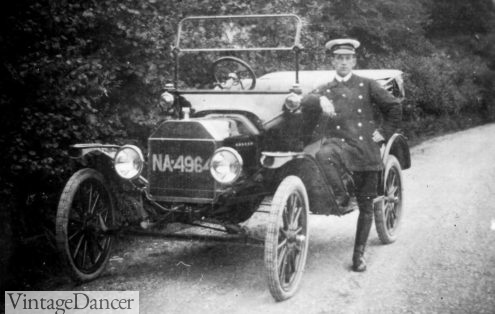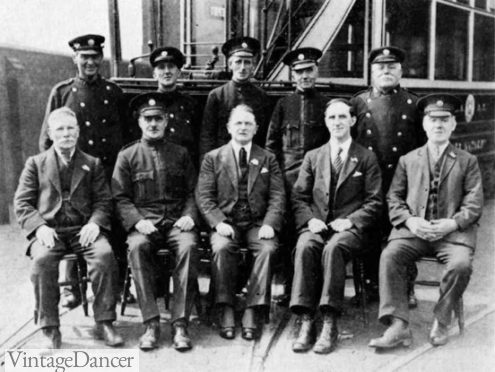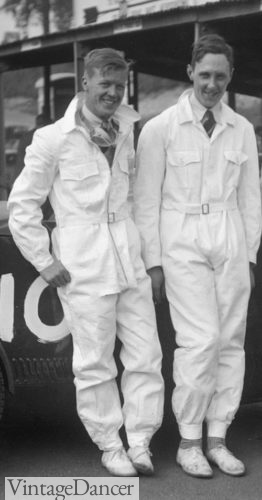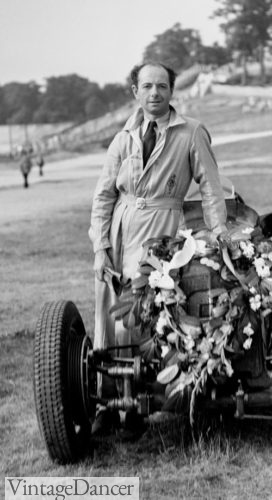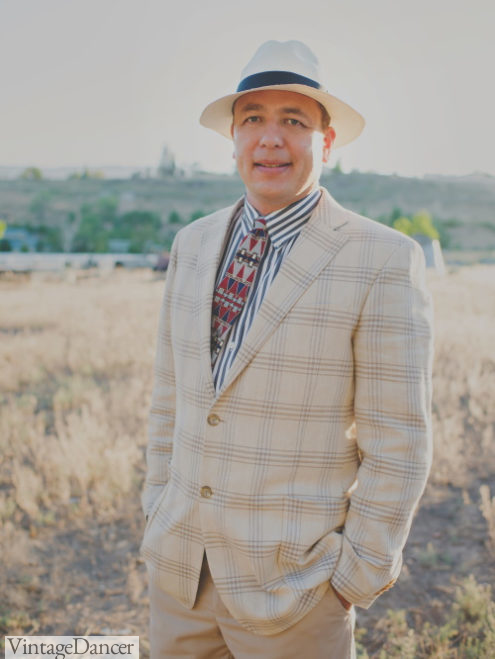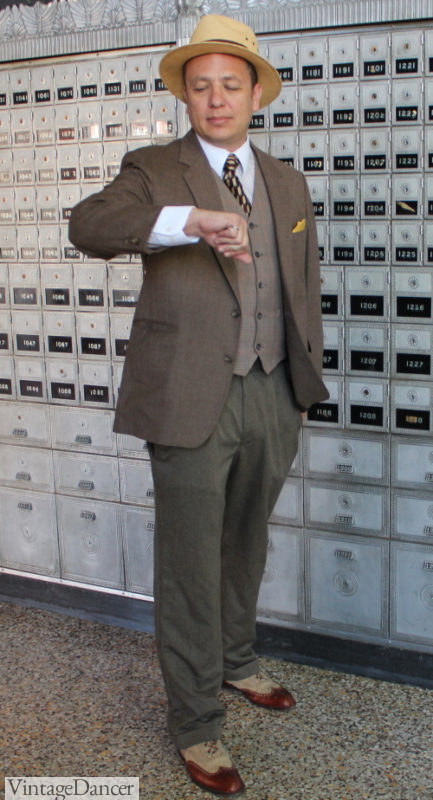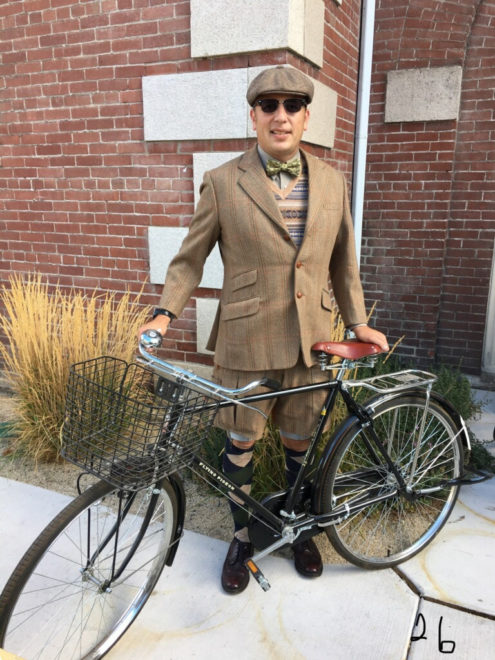Where the 1920s was an age of revolutionizing automobile ownership, the 1930s was a decade of technological innovation, transformation, and unparalleled beauty. It was also a time of huge strides that brought cars closer their modern shape, style, and function. With that considered, it’s no wonder that 1930s cars are popular for shows like the Pebble Beach Concours D’Elegance, Cruisin’ the Coast, Hot August Nights, and many other antique motoring shows.
The topic of today’s article is dedicated partly to 1930s car culture and partly to unique 1930s outfit ideas for your 1930s classic car show. Whether you’re showing a car or simply attending, there is countless inspiration for 1930s car show outfit ideas that will elevate your presence and make you stand out — or in the case of costumed car shows, fit in!
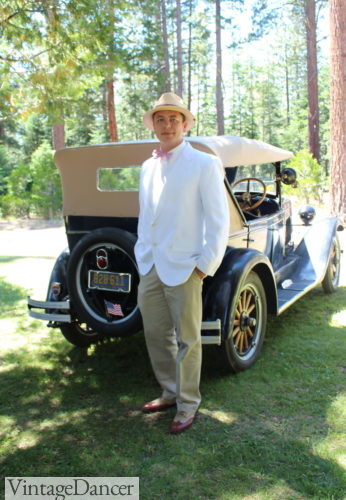
An easy outfit for a 1930s car show – white suit jacket, light trousers, two tone shoes, straw fedora hat, bow tie, and spearpoint collar shirt.
1930s Car History and Culture
1930s Cars: Beautiful Designs in Hard Times
The Great Depression took its toll on the American population. Times were hard, yet all the while cars became more big, beautiful, and luxurious…
… With an emphasis on big. Compared to cars of the early ’20s, 1930s cars were absolutely massive. Advancements in internal combustion engines allowed them to get bigger and more powerful. This in turn led to cars themselves growing larger and heavier. Hardtops, more body panels, and new seating arrangements all shifted the car away from the 1800s buggy shape and towards a more modern silhouette. Also new were the amenities these cars could support: air conditioning, heating, radios, automatic transmissions, windshield defrosters, and mass-production steel bodies were new or improved in the 1930s.
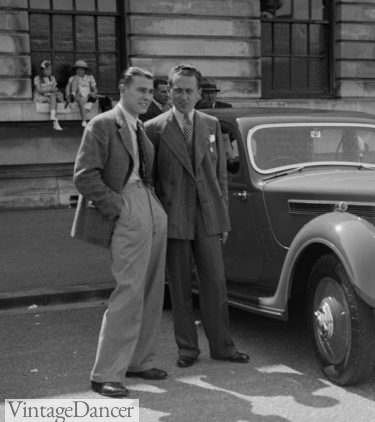
1930s Suits and Sportscoats [Rover 4-door saloon of FD Cooper at the South Wales Auto Club Welsh Rally, 1937 Rover 4-door saloon 1936 (Photo by National Motor Museum/Heritage Images/Getty Images)]
- 1932 Ford Model B, and its Successor…
- 1935 Ford Model 48, with Art Deco Styling
From this growing emphasis on beauty and style emerged the beginnings of the custom car scene. Custom car culture would not get big until the late 1940s, but most agree that it started in the 1930s. Body shops and visionaries both within and outside of the automotive field would experiment with more and more custom body styles as the decade progressed. We will go more into this later.
1930s Car Owners and Uses
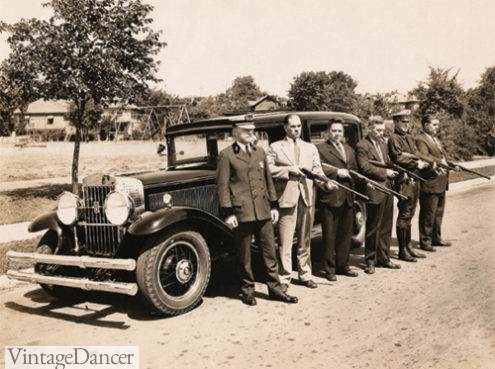
For those with more nefarious careers, high-powered engines allowed for armored cars and modifications. Pictured is the Bank Flyer, a car made for breaking through brick walls for bank robberies (1930-1931).
Many Americans held onto their cars for as long as they were able, driving older models into and even through the 1930s. While rates of new car ownership were down, people stayed on the road as much as they feasibly could.
For the fortunate few who could afford to keep with the times, cars in the 1930s were an expression of wealth and power. Comfort ushered in a new generation of cars to be driven in, while big-displacement engines allows cars to serve as toys for the wealthy. Even among those who could not afford them, car performance and power was appreciated in the form of auto spectacle shows that toured the 1930s countryside.
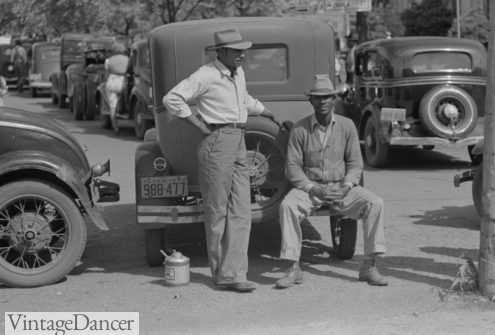
1939 San Augustine, Texas. Casual Clothes for These Men
Powerful engines and more structurally sound bodies in the 1930s also birthed stunt driving. Made famous by Early “Lucky” Teter, 1930s car stunt bands were a major source of entertainment during hard times. These shows promised “thrills and spills” as drivers sent cars flying, flipping, and crashing through flaming bales of hay or into other cars. Skilled stunt drivers began to find themselves wanted for movies as well.
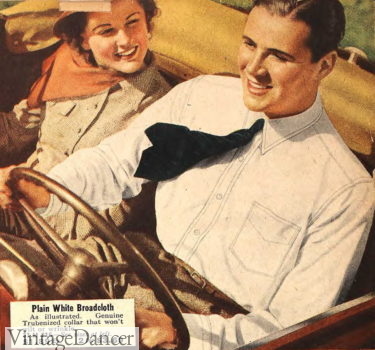
1938 Driving in a Broadcloth Dress Shirt and Tie
Racing found itself undergoing major changes — most notably, its formalization and newfound exclusivity. Unlike the previous decades, the 1930s ushered in many rules and structure that would modernize racing. The cost of high performance vehicles and tight budgets of the decade also made performance racing largely a hobby for the rich. The land speed record, under regular contest through the decade, was also mostly broken by the wealthy. By 1939, the fastest man on the ground topped out at a hair under 370mph.
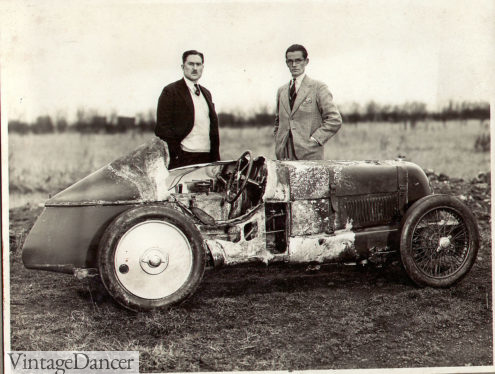
Multiple Land Speed Record-Breaker George Eyston with a damaged MG Midget, 1931
1930s Car Show Costume Ideas for Men
Gangster / Mobster
Prohibition carried on through the early years of the 1930s, so it’s no surprise that gangsters like Al Capone made good money. 1930s gangsters were involved in bootlegging, gambling, prostitution, smuggling illicit goods (armored cars, weapons, etc), and more. For recruitment purposes (or to feed their ego), most high-profile celebrity gangsters flaunted their affluence with pride. They wore new suits, drove new cars, and dressed every part of what they were worth.
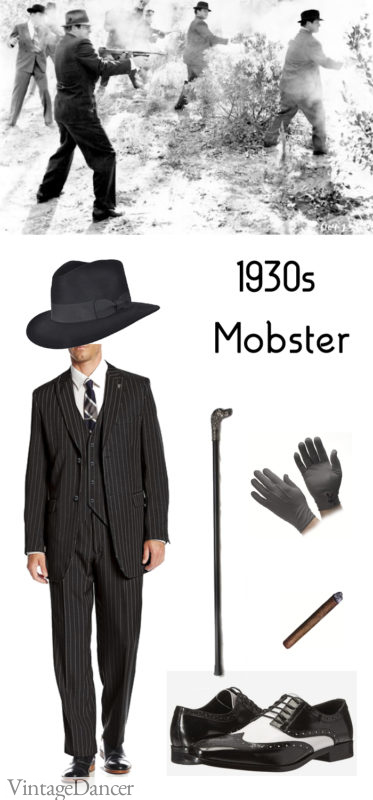
How To: Your 1930s gangster costume should be sharp and luxurious, at the cutting edge of fashion of the era. The most recognizable look would be a black three-piece suit with wide chalk stripes, black and white two-tone shoes, black gloves, and a homburg hat. Add a cigar, cane, or overcoat for the full effect. Navy, brown, and dark grey were other popular colors through the decade. Click here to read a full overview of 1930s men’s fashion trends.
While the “celebrity gangsters” of the era were undeniably dripping with money, that was not the case for everyone. Moonshine runners and mobster grunts generally wore workwear of the era, driving cars that were a few years out of date.
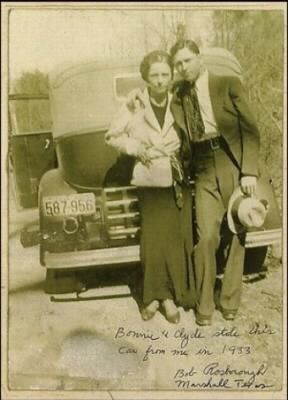
1933, Clyde Barrow, Famous Gangster, Wears a Typical 1930s Suit with Belt, Tie, and Fedora Hat
1930s Chauffeur
The 1930s was an era of “cars to be driven in,” where the elite could sit comfortably by and leave the driving to somebody else. The chauffeur uniform had changed little since the 1910s, making it an excellent and recognizable choice.
A 1930s chauffeur uniform was was similar if not identical to public transport and postal service uniforms of the era. It was commonly navy or grey (occasionally black, rarely olive or khaki) with a double breasted jacket reaching to around mid-thigh. The pants varied — in the 1930s, jodhpurs were the most common, followed by wide legged pants. Both were worn with high boots. Black or white gloves were often worn alongside a cap that matched the chauffeur’s uniform.
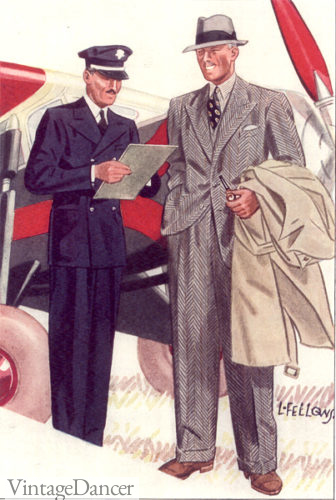
1920s chauffeurs had slimmer trousers, with either knee-high boots worn over the pants or ankle boots worn under them. Edwardian chauffeur uniforms were similar with slim pants/jodhpurs and a boxier coat. The earlier decades also carried less military-esque details.
For the most part, the chauffeur’s jacket was buttoned closed and did not show much of his shirt collar/tie. This high-neck silhouette would give way to a more standard peacoat shape by the late 1930s/early ’40s, in both single- and double-breasted forms. Epaulettes and other military details would begin to show in the late 1930s.
- 1910s Chauffeur
- Chauffeur and Car, 1920s
- 1931 South Shields Corporation Tramways Uniform
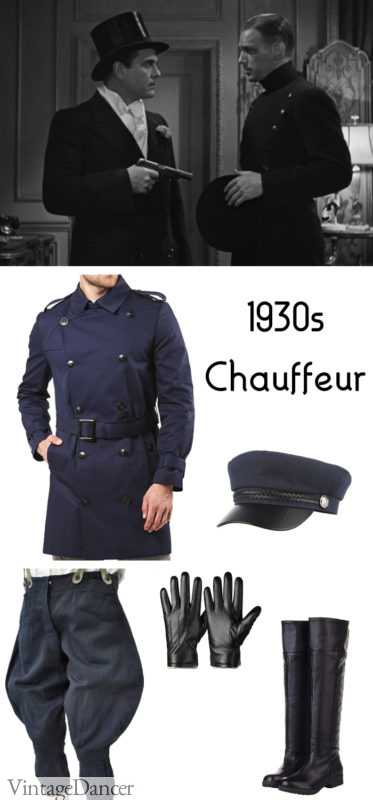
How To: Peacoats tend to lack the neckline that makes the chauffeur uniform of the era so distinct. If you can find a high-neck mid-thigh peacoat in blue or medium grey then that would work great. It may be easier finding a raincoat of the same description, however. You could also seek out reproduction uniforms — FormalTailor (UK) offers a great one. Also ask uniformsbypark (USA) if they can make one.
Complete it with jodhpurs or wide legged pants of the same color, knee-high boots (worn over the pants), a matching hat, and black gloves. For 1930s style, the jacket should have a classic fit but the trousers should be loose and large.
Hell Driver / Stuntsman
This simple yet unique costume idea is great for cars of any model. Even without a flashy name painted onto the side of your car, a 1930s stunt driver costume can encompass everything from a stock racer to Lucky Teter himself. It was also a uniform shared among racers, pit mechanics, and other related fields of the era. A bit of creativity and customization can open a world of possibilities for your 1930s car show costume.
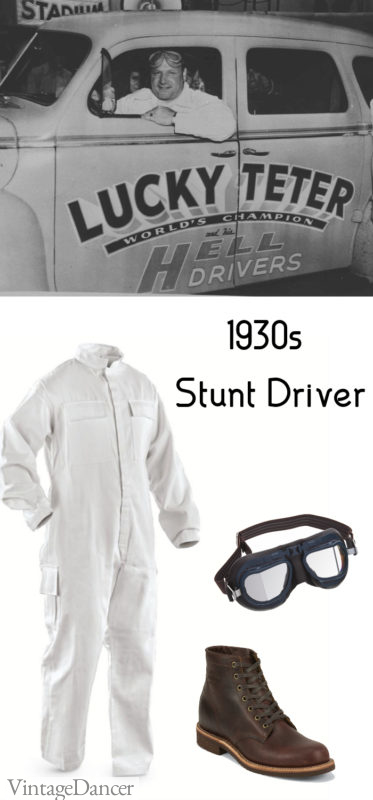
How To: Begin with a set of white or light khaki loose-fitting coveralls. Accessorize simply, with some worn ankle boots and a pair of goggles. Adding scuff marks, oil stains, or an arm band can add character to the look.
For a sportier racing style, add a period-accurate half helmet (leather, think pilot cap), jacket, and scarf. Think classic aviator, but with a white jumpsuit instead.
- Racing drivers with a Lea-Francis 1496 cc at Brooklands. Lea Francis 1496S cc. Event Entry No: 10. Place: Brooklands. Artist Bill Brunell. (Photo by National Motor Museum/Heritage Images/Getty Images)
- Raymond Mays with his ERA at Brooklands, Surrey, 1936. Artist: Bill Brunell. (Photo by National Motor Museum/Heritage Images/Getty Images)
Hollywood Casual
With “talkies” on the big screen becoming a major phenomenon seemingly overnight, Hollywood’s influence exploded. What 1930s celebrities wore affected men’s clothing, becoming a driving force of what to wear. In the 1930s, this led to a growth in sporty simplicity. Polos, slacks, sports shoes — all casual clothing that was easy to wear and affordable. For the comfortable classes who were able to own newer cars, following Hollywood stars was a no brainer.
This is a great costume idea for any “new” vehicle of the 1930s. Not only that, but it is just as easy and comfortable as it always was.
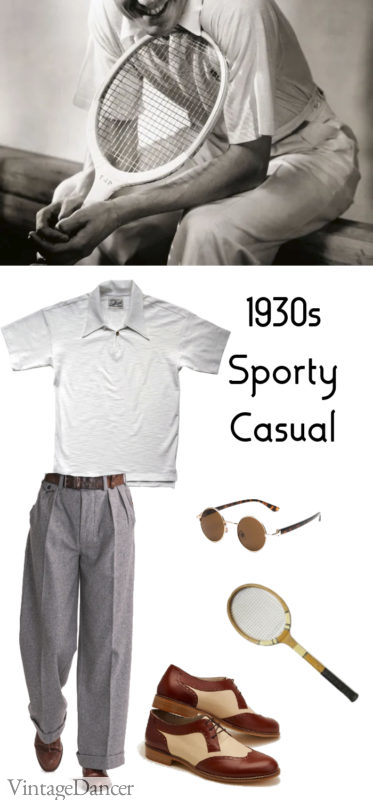
How To: Polo shirts and pants are incredibly easy to find. The 1930s flair of this outfit is entirely in the details. Opt for a polo shirt or T-shirt in solid white, a rich solid, or a vintage style pattern. SJC’s vintage style “Deco Polo,” pictured, has a great collar. Trousers should be a solid “summery” color – white, cream, navy, or grey – worn baggy and high on the waist with a belt. Brown-tan or brown-white two-tone shoes add a great vintage flair, while some round metal/tortoiseshell-frame sunglasses put you at the cutting edge of the new 1930s sunglasses craze.
Accessorizing with a wood tennis racket or golf clubs can add to the sportiness. It’s also a great prop to leave in a car.
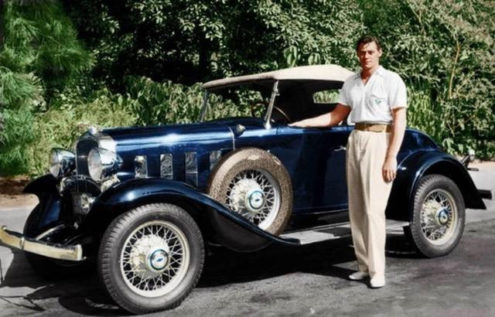
Casual Attire – Polo Shirt, Wide Leg Trousers, Wide Belt, and White Oxford Shoes
More Accurate 1930s Men’s Clothing Ideas
It’s hard to cover a whole decade of costume ideas in just one article. Vintage Dancer is a great resource for 1930s men’s fashion history from the start to the end of the decade. Click here for an in-depth guide to 1930s men’s fashion.
For more 1930s costume ideas, click here. Or read into 1930s men’s casual fashion here.
Shop 1930s style men’s suits, shirts, pants, hats and more here. Also browse this list of stores selling reproduction 1930s men’s clothing for the most accurate outfits.
- 1930s Sportscoat over Tan Pants with Blue Striped Shirt, Patterned Tie, and Straw Panama Hat
- Thrifted 30s Outfit – Mismatched Brown Jacket, Vest, and Green Pants
- Men’s Tweed Ride Outfit Based on a Vintage Riding Pattern
Notes on the Future and the Past
Cars of the 1930s were dirt cheap in the late ’40s and 1950s. Their cheapness and aesthetics made them a great candidate for high schoolers (or even adults!) to style up into hot rods. While both aesthetic and performance modifications did exist in the 1930s in a good amount, many “1930s customs” today were, in fact, made in the ’40s and ’50s. Some may be obvious — that lowered Ford with the candy apple paint job and Y-block engine — but others may not. When is a chopped top too chopped of a top to be 1930s? Without some record, it can be pretty hard to tell!
For the sake of accuracy, owning a 1930s car that was customized in a later decade is probably best accompanied with clothing from the customized decade. In a similar vein, cars of the 1920s can and should be worn with early-mid 1930s clothing without issue. Much like today, not everybody bought new every year. In a decade of hardship, this was all the more obvious.
Read More:
- Edwardian Men’s Motoring Clothes
- Accurate 1920s Classic Car Show Costumes
- Accurate 1940s and WWII Classic Car Show Outfits
